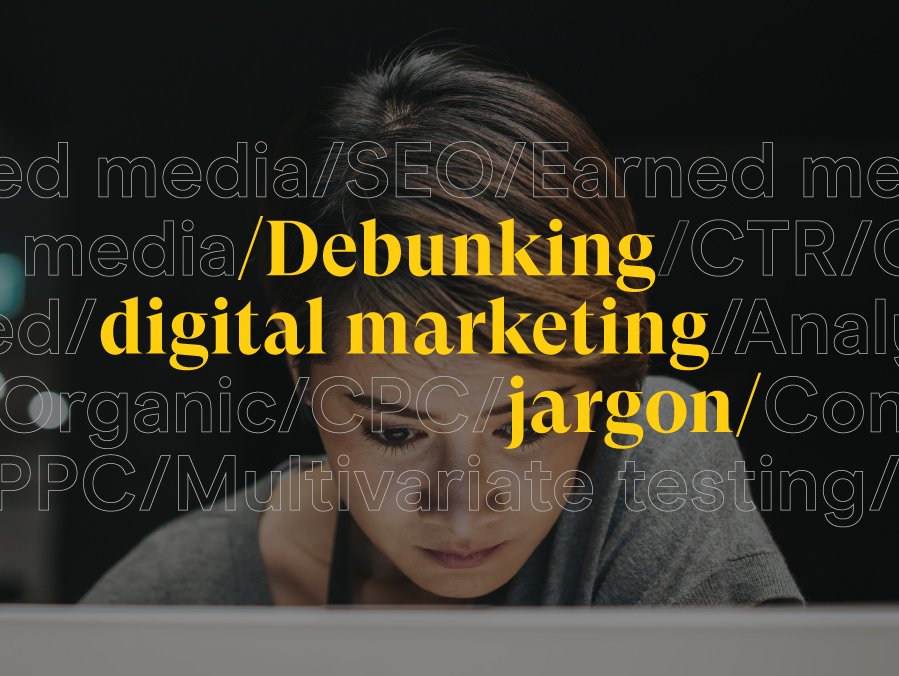Every sector or discipline comes with its own jargon which can feel like you need a translation service to decipher sometimes. Digital marketing is no exception and for the healthcare sector, we want to make sure the terminology we’re using is clear for our clients to understand when we’re working together and advising how to best use digital marketing budgets.
We’ve put together a quick cheat sheet to help you become more fluent in digital language.
The first core media categories to be aware of are:
- Owned media – this typically covers, your brand’s website, blog and any content you’ve created.
- Earned media – anything where your brand gains exposure by a third party that isn’t paid for. For examples, awards, PR coverage
- Paid media – as you’d expect this is any type of advertising that required budget, such as Google Ads, sponsored social media ads or display ads.
- Shared media – typically shared media sits in organic social media (meaning its not paid posts). There’s some cross over with earned here as individuals/ bloggers /influencers might endorsed a brand or service without payment.
A/B testing (split or multivariate testing)
This is a technique that tests different versions of something to see which drives the best results. This might be a different lay out on a website page, different wording on a call to action or perhaps changing subject titles in emails.
Analytics
This is data often stored and displayed on dashboards to track performance in social media, website or email campaigns. Google Analytics is one of the widest used performance tools digitally, which can be set up to produce custom reports, demographic data and much more.
Bounce rate (%)
This is when visitors come onto your website and only look at the page they landed on and then leave. Typically you might want your bounce rate to be low, so that visitors are spending more time on your site, however a single page’s bounce rate being high could indicate that the visitor found the information they were looking for.
Call to action (CTA)
Call to action is one of the more self-explanatory phrases in digital marketing jargon. Simply put, a link or a button that encourages an action from your audience is a CTA. For example, a contact us form, a ‘download’ button on a website or ‘register here’ link on a social media post.
Click-through-rate (CTR)
This is a metric, it’s mostly associated with social media ads, paid per click ads (PPC), email marketing or sometimes CTAs on websites. Click through rate is the number of people that click on a link, divided by the totally number of people who saw the email or ad, multiplied by 100.
For example, if 1000 people saw your ad on LinkedIn and 150 people clicked on it, the CTR would be 15%.
(150 / 1000) x 100 = 15%
Conversion rate
A conversion in digital marketing terms, is when a user, individual, has completed a desired action. The conversion rate (%), is the number of people who have converted, divided by the total number of people to whom were targeted.
For example, if an email advertising a new medical whitepaper was sent to 1000 people and 250 clicked to download the whitepaper, the conversion rate would be 25%
Cost-Per-Click (CPC)
This metric is used with paid ads (like you see at the top of Google) or social media ads. This is the amount that the advertiser pays each time a user clicks on their ad. A benefit of paid ads is that your content could be shown to an unlimited volume of people (impressions this is called) but you only are charged when someone clicks.
Organic vs Paid Traffic
Organic is the term used in digital marketing that refers to website visits that occurred without paid media or referral. This is normally where your website comes up on a Google search and is clicked by a user or perhaps through a post on one of your social channels.
Paid traffic is where a website visit has occurred through a paid medium, such as a social media ad or Google ad.
PPC
Also referred to as Pay-Per-Click. PPC is an advertising model used to drive traffic and boost online brand visibility. Its most commonly associated with top tier search engines like Google. Ads can be found at the top and bottom of results pages.
Search engine optimisation (SEO)
This is the technique used to rank your website highly on Google (Bing / Yahoo) search engine results pages. This is a specialism that can be split out to technical and content changes needed to improve online visibility of a website. SEO focusses on organic traffic, which means its not paid for with ads.
Learn more than just jargon
The list of language and terminology goes on, but these are some of the most commonly used phrases and metrics that we think businesses would benefit from being aware of. The team at BBI Health aren’t here to sound smart, we pride ourselves in really getting to know and understand our clients and their audiences and come up with solutions that make sense to everyone.
To learn more about how to elevate your digital marketing strategy, download your free copy of our Digital Marketing Guide.


